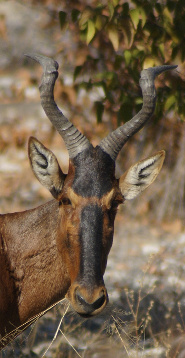 Hartebeests (Alcelaphus buselaphus) are the African antelope. Had Dr. Brewster M. Higley, who wrote the poem "Home on the Range," visited Africa, the poem might well have said: "Home, home on the range, where the deer and the hartebeests roam." In 1876 when Dr. Higley penned the now famous poem, it ranged the entirety of Africa from Morocco and Egypt in the north, to South Africa, Nambia, and Botswana in South. Now, due largely to the extinction of the Bubal Hartebeest that grazed the grasslands and forests of Northern Africa, hartebeests are no longer found in the north.
Hartebeests (Alcelaphus buselaphus) are the African antelope. Had Dr. Brewster M. Higley, who wrote the poem "Home on the Range," visited Africa, the poem might well have said: "Home, home on the range, where the deer and the hartebeests roam." In 1876 when Dr. Higley penned the now famous poem, it ranged the entirety of Africa from Morocco and Egypt in the north, to South Africa, Nambia, and Botswana in South. Now, due largely to the extinction of the Bubal Hartebeest that grazed the grasslands and forests of Northern Africa, hartebeests are no longer found in the north.The word hartebeest is derived the Dutch word for deer, hertebeest. In general, they stand nearly 5 feet at the shoulder (1.5m) and weigh between 265-440 lbs. (120-200 kg). Their body style is more muscular than other antelope with high withers and sloping hindquarters. Their elongated head gives them a horsey countenance.
Both males and females have horns that can extend as long as 27 inches (70 cm).
The shape of the hartebeest's horns is one way to determine the specific subspecies. There are three basic horn patterns for the hartebeests:
• The U-shaped horns distinguish hartebeests that graze in the west African countries of Cambela, Nigeria, and Cameroon.
• The V-shaped horns are found on hartebeests in southern Africa.
There are many subspecies of hartebeests: Coke's, Jackson's, Red, Swayne's , Lelwel, Tora, and Bubal to name a few. Only one is extinct, the Bubal Hartebeest. The Bubal Hartebeests were once domesticated by the Egyptians as a food source. Horns from the Bubal Hartebeest found in the tombs at Abadiyeh give credence to the animal's importance to ancient Egyptian culture. Unfortunately, the Bubal Hartebeest was widely hunted, and the last Bubal Hartebeest died in 1923 in the Paris Zoo.
Picture of the red hartebeest by Hans Hillewaert, licensed under Creative Commons Attribution-Share Alike 3.0 Unported license.
Keywords: brown , yellow , horn , diurnal
The Common hartebeest, hartebeest is listed as Conservation Dependent (LR/cd), the focus of a continuing taxon-specific or habitat-specific conservation programme targeted towards the taxon in question, the cessation of which would result in the taxon qualifying for one of the threatened categories below within a period of five years, on the IUCN Red List of Threatened Species
Countries
Algeria, Angola, Benin, Botswana, Burkina Faso, Cameroon, Central African Republic, Chad, Congo, Democratic Republic of the, Cote d'Ivoire, Egypt, Eritrea, Ethiopia, Gambia, The, Ghana, Guinea, GuineaBissau, Kenya, Lesotho, Libya, Mali, Morocco, Namibia, Niger, Nigeria, Senegal, Somalia, South Africa, Sudan, Swaziland, Tanzania, Togo, Tunisia, Uganda and ZimbabweHartebeest habitats
Dry savanna, Grassland, Savanna, Shrubland, Subtropical / Tropical Dry Grassland and Subtropical / Tropical Dry ShrublandSome facts about the
Hartebeest
Adult weight : 159 kg (349.8 lbs)
Maximum longevity : 23 years
Female maturity :730 days
Gestation : 247 days
Weaning : 193 days
Litter size : 1
Litters per year : 1
Interval between litters : 365 days
Weight at birth : 9.05 kg (19.91 lbs)

Custom Search